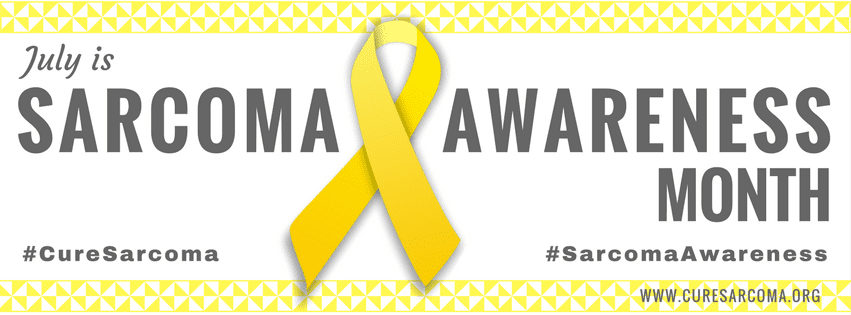
July is Sarcoma Awareness Month
Sarcoma is still considered to be the “forgotten cancer.” Efforts to encourage research and drug development are made more challenging due to a lack of awareness and understanding. How as a community do we raise funds for vital research if people don’t know that this cancer exists?
Though the Sarcoma Foundation of America works tirelessly every day to raise awareness, during Sarcoma Awareness Month we aim to further highlight the extraordinary challenges that sarcoma patients face and the need for more sarcoma research and better sarcoma therapies.
What is Sarcoma
Sarcoma is a rare cancer in adults (1% of all adult cancers), but rather prevalent in children (about 20% of all childhood cancers). It is made up of many “subtypes” because it can arise from a variety of tissue structures (nerves, muscles, joints, bone, fat, blood vessels – collectively referred to as the body’s “connective tissues”). Because these tissues are found everywhere on the body, Sarcomas can arise anywhere. Thus, within each site of the more “common” cancers there is the occasional surprise sarcoma diagnosis (e.g., breast sarcoma, stomach sarcoma, lung sarcoma, ovarian sarcoma, etc.). The most frequent location are the limbs since this is where the majority of the body’s connective tissue resides. They are commonly hidden deep in the body, so sarcoma is often diagnosed when it has already become too large to expect a hope of being cured. Although a lot of the lumps and bumps we get are benign, people should have them looked at by a doctor at an early stage in case it is sarcoma.
Sarcoma is sometimes curable by surgery (about 20% of the time), or by surgery with chemotherapy and/or radiation (another 50-55%), but about half the time they are totally resistant to all of these approaches—thus the extreme need for new therapeutic approaches. At any one time, more than 50,000 patients and their families are struggling with sarcoma. More than 16,000 new cases are diagnosed each year and nearly 7,000 people die each year from sarcoma in the United States.
How Do You Treat Sarcoma?
In general, treatment for sarcomas depends on the stage of the cancer. The stage of the sarcoma is based on the size and grade of the tumor, and whether the cancer has spread to the lymph nodes or other parts of the body (metastasized). Treatment options for sarcomas include surgery, radiation therapy, and chemotherapy.
Surgery is the most common treatment for sarcomas. If possible, the doctor may remove the cancer and a safe margin of the healthy tissue around it. Depending on the size and location of the sarcoma, it may occasionally be necessary to remove all or part of an arm or leg (amputation). However, the need for amputation rarely arises; no more than 10 percent to 15 percent of individuals with sarcoma undergo amputation. In most cases, limb-sparing surgery is an option to avoid amputating the arm or leg. In limb-sparing surgery, as much of the tumor is removed as possible, and radiation therapy and/or chemotherapy are given either before the surgery to shrink the tumor or after surgery to kill the remaining cancer cells.
Radiation therapy (treatment with high-dose x-rays) may be used either before surgery to shrink tumors or after surgery to kill any cancer cells that may have been left behind.
Chemotherapy (treatment with anticancer drugs) may be used with radiation therapy either before or after surgery to try to shrink the tumor or kill any remaining cancer cells. If the cancer has spread to other areas of the body, chemotherapy may be used to shrink tumors and reduce the pain and discomfort they cause, but is unlikely to eradicate the disease. The use of chemotherapy to prevent the spread of sarcomas has not been proven to be effective. Patients with sarcomas usually receive chemotherapy intravenously (injected into a blood vessel).
Doctors are conducting clinical trials in the hope of finding new, more effective treatments for sarcomas, and better ways to use current treatments.
Click here for a list of medical centers and hospitals specializing in sarcoma. While the list is not comprehensive, it includes the leaders in sarcoma research and treatment. Because sarcomas are rare, it is important to find physicians and multidisciplinary treatment centers that have experience with this disease.
Click here for list of Clinical Trials that may be helpful.







